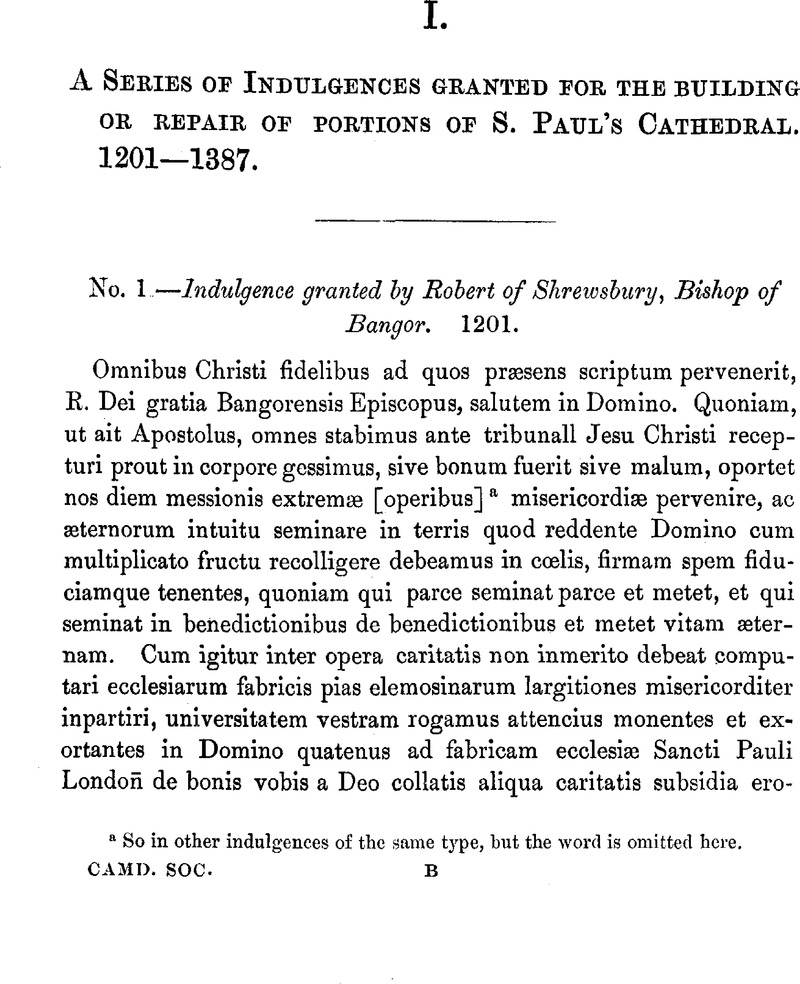No CrossRef data available.
Published online by Cambridge University Press: 24 December 2009

page 1 note a So in other indulgences of the same type, hut the word is omitted here.
page 2 note a From the original preserved in S. Paul's Cathedral. A small fragment of the scal remains.
page 2 note b From the original preserved at S. Paul's. Part of the seal remains.
page 3 note a A list of altars and of chapels in the cathedral will be found in the Appendix, Notes B and C.
page 3 note b Alexander Swerford, treasurer of S. Paul's 15 January, 1231–2, who died in 1246, and was buried in S. Paul's Cathedral. He seems to have resigned his office before his death. (Le Neve, Fasti, edit. Hardy.) He built the altar of S. Chad in his lifetime, and founded a chantry of one priest to celebrate thereat after his decease. He was buried before this altar. (Dugdale, , S. Paul's, p. 19Google Scholar) The revenues of the chantry were estimated at five marks at Bishop Braybrooke's visitation in 14 Richard II. (Ib. p. 26.) At Dean Ralphde Baldock's visitation in 1295, Johannes de S. Radegunda was the chantry priest. (Ib. p. 333.) Alexander himself presented to the cathedral a cope “de rubeo sameto, breudata cum nodis interlaqueatis, et regibus et episcopis.” (Ib. p. 317.) Two other indulgences are still preserved in the cathedral, in which Hugo Norwold, Bishop of Ely, grants, in the one thirty days', in the other ten days', indulgence to those who shall pray for the soul of this same Alexander and contribute to the work. Both indulgences are dated at London, “die Sanctæ Luciæ,” 1247.
page 3 note c Stepney. The manor of Stebunheath, or Stepney, anciently belonged to the Bishops of London. Bishop Ridley “was fain to alienate to the King,” Edward VI. this and other manors, “in exchange for others of the like value.”—Strype, Memorials, vol. ii. part 1, p. 339Google Scholar, ed. Oxford, 1822.
page 3 note d From the original, preserved at S. Paul's. The whole indulgence is very carefully written. Part of the seal remains.
page 3 note e Walter Cantilupe, Bishop of Worcester; William of York, Bishop oE Salisbury; and Richard Blondy, Bishop of Exeter.
page 4 note a Pope Innocent IV.
page 4 note b Innocent IV. was elected Pope in June, 1243. The date of this bull will, therefore, be 16 Kal. Sept. 1252. As the year began in March, 16 Kal. Sept. occurred before 9 Kal. Feb., the date at which the bull was promulgated in England.
page 4 note c From the original in the British Museum. Add. Ch. 5957. (From Bishop Butler's Library, 1841.) Indorsed in an early hand, “Subscriptum literarum de indulgencia uni anni et xl dierum.” Three seals have been appended; portions only of the first remain.
page 5 note a Was this, asks Dean Milman (Annals, p. 161Google Scholar, note 2), some confusion for the tomb of Edward the Confessor in the Abbey? I have not met with any other allusion to this altar than that which this indulgence supplies.
page 5 note b Daughter to William, King of Scotland, and wife to Robert, Lord Brus, of Anandale. (Dugdale, , p. 10Google Scholar) One Bichard de Brus presented to the cathedral a “Baudekynus rubei campi cum leopardis maculatis in circulis, et avibns extra.”— Ib. p. 329.
page 5 note c From the original preserved at S. Paul's. Part of the seal remains.
page 6 note a Henry de Wengham had the King's letters of protection as Archdeacon of Middlesex, dated 20th January, 1266–7. He died 23rd Oct. following.—Le Neve's Fasti.
page 6 note b Part of the seal, together with the plaited cord, remains. The indulgence is written in a clear, bold hand. It is preserved amongst the cathedral archives.
page 6 note c Endorsed, Herefordensis Episcopns. A small fragment of the seal remains. The original is preserved inS. Paul's.
page 6 note d Roger Niger, Bishop of London, died at Stepney 29th Sept. 1241, according to Dugdale, p. 58 (where an engraving of the tomb is given); but see Le Neve's Fasti. The epitaph gives the date of his death as 1240, a tablet hanging near the tomb as 1241. He was canonised after his death; his fête was held 29th Sept. (lb.) In Dugdale's ground-plan of S. Paul's the tomb is shown standing between the fifth and sixth pillars (reckoning from the west) of the choir, and touching the fifth pillar. Roger Niger had been a great benefactor to the cathedral. See Dugdale, pp. 8,218. Amongst the relics preserved in the cathedral were these:—
“Pulvinar magnum ‥ quod fuit Episcopi Rogeri.
Capa S. Rogeri Episcopi, de rubeo sameto, breudata cum stellis et rosis.”—
Dugdale, 316, 317.
page 7 note a Paul's Cross, afterwards rebuilt by Bishop Kempe, “as his arms, in sundry places of its leaded cover, do manifest.”—Dugdale, p. 88.
page 8 note a The original is preserved at S. Paul's. There are no remains of the cord or seal. This indulgence is endorsed:—

Another endorsement is— De Cimiterio S. Pauli. Cant'.
Several other indulgences granted for the same purpose are preserved in the archive room. One, granted by Eobert Braybrook, Bishop of London, in 1387, is printed in Appendix C to Dean Milman's Annals, pp. 520–521Google Scholar: on a piece of vellum folded round the seal are written the names of the dioceses of Canterbury, Ely, London, Bath, Chester, Carlisle, Llandaff, and Bangor, and after each, “xl. dies,” as above.
In Appendix A (of the present volume) will be found a complete list of the Indulgences which are still preserved in the cathedral archive room.